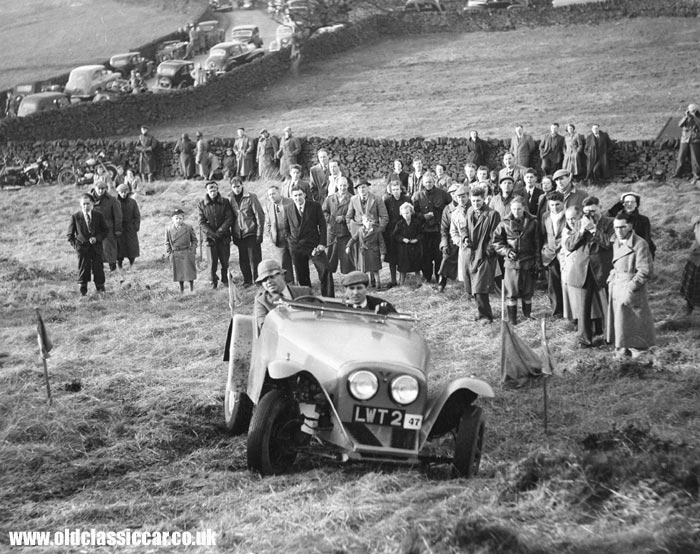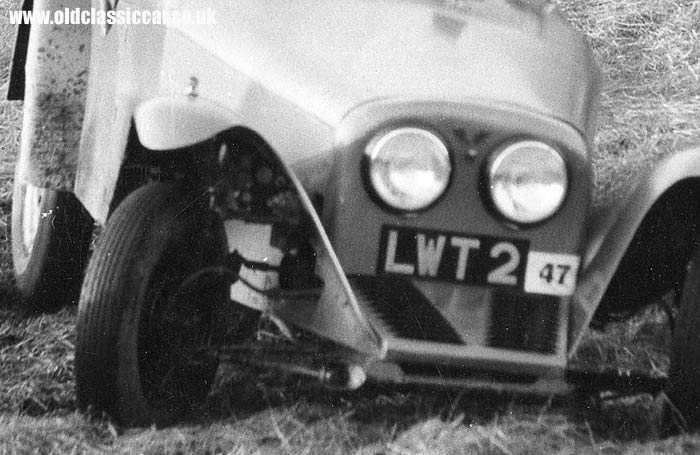Post-war car trials.
Thanks to David A who emailed this photo over. He's intrigued by the car shown in this picture, and adds the following information:
|
"Perhaps you can help with identifying the trials car in the attached photo. I've had this photo amongst my late father's press albums for many years. He was actually heavily involved in motorcycle sport, being a NW centre ACU official and president of the North Lancs Motorcycle Club. The photo was taken on a car trial in the early nineteen fifties, possibly a Lancs Auto Club event and probably somewhere in the Lancs/Yorks border area, I do recall going to watch this trial as a young lad and I vaguely recall this car. For some reason I think it's based on a Chrysler, don't ask me why. The back of the photo has the single name 'Ashworth' written on it. Now I do recall my father knew a Jack Ashworth, possibly the Jack Ashworth that rode a works BSA in late 1940's m/cycle trials, and I do know from contemporary Autosport reports in my archive that there was a Jack Ashworth who competed regularly in northwest car events in the 1950's, perhaps one and the same person.
If your website readers can shed any light I'd be absolutely delighted."
|

|
|
It's an interesting photo definitely. Whatever the trials car is, cooling to the rad couldn't have been too clever with just two rows of louvres set into the panel beneath the car's registration plate (LWT 2). The car's front wheels look to be smaller in diameter than the rears, whether the car is large enough to be Chrysler-based it's hard to say. LWT was a Yorkshire registration, first used in 1952, which ties in nicely with David's guess at the early 1950s for this photograph. It certainly looks like a well attended event, judging by the number of onlookers, and vehicles parked in the distance. With fuel in short supply, any motorsport event would have been a welcome distraction to the daily routine for the enthusiastic motorist of the day. Below is a close-in look at the car in isolation.
|

|
|
Interest in trials and hillclimbs immediately after the war boomed, given that the two main racing tracks used for the final time in 1939 (Brooklands and Donington) were in no fit state for serious motorsport to re-commence. It took circuits based on former airfields, such as Silverstone and Goodwood, to re-introduce large scale circuit racing to the masses. Until this happened, muddy hillsides, plus speed hillclimb and sprint courses, were the main post-war motor racing venues.
|
What is a trial?
Trials are still popular today, and are unusual in that outright speed is not the objective. A trial consists of several sections, each being a distinct climb designed to test driver, passenger and the car over different surfaces and conditions. The idea is to ascend each section, preferably to the finish line, scoring points, based on how far you get up the hill before ambition exceeds adhesion (as one F1 commentator described losing grip). The passenger doesn't come along for the ride, his or her role is to bounce like crazy whenever extra traction is required to the driven wheels. Rear tyre pressures are often lowered, in a bid to increase their surface area and thus increase grip.
|
|
Other trialling information on oldclassiccar includes a series of photos showing an Austin-based trials car competing between 1949 and 1951. Recollections from someone whose Grandfather trialled a Ford-based car in 750 Motor Club events in this era, can be found in the Motoring Memories section. This page features a variety of different cars competing in a post-war event.
|
|
Return to Old Motoring Photos Page No. 9.
|







